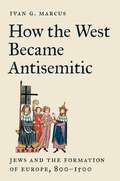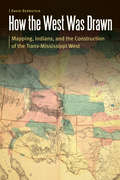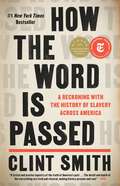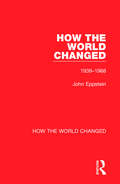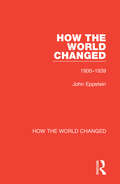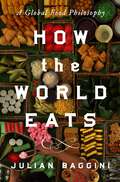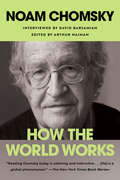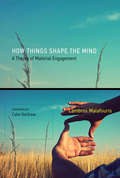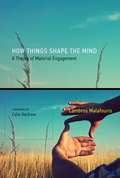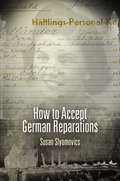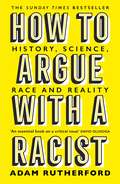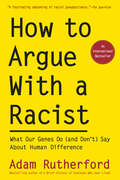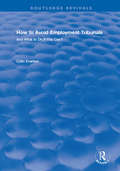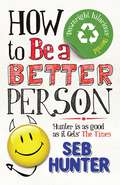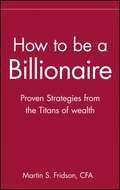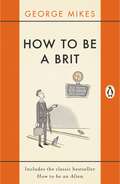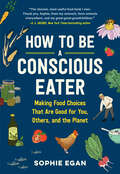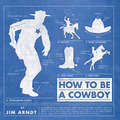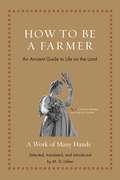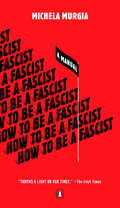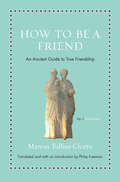- Table View
- List View
How the West Became Antisemitic: Jews and the Formation of Europe, 800–1500
by Ivan G. MarcusAn examination of how the Jews—real and imagined—so challenged the Christian majority in medieval Europe that it became a society that was religiously and culturally antisemitic in new ways In medieval Europe, Jews were not passive victims of the Christian community, as is often assumed, but rather were startlingly assertive, forming a Jewish civilization within Latin Christian society. Both Jews and Christians considered themselves to be God&’s chosen people. These dueling claims fueled the rise of both cultures as they became rivals for supremacy. In How the West Became Antisemitic, Ivan Marcus shows how Christian and Jewish competition in medieval Europe laid the foundation for modern antisemitism.Marcus explains that Jews accepted Christians as misguided practitioners of their ancestral customs, but regarded Christianity as idolatry. Christians, on the other hand, looked at Jews themselves—not Judaism—as despised. They directed their hatred at a real and imagined Jew: theoretically subordinate, but sometimes assertive, an implacable &“enemy within.&” In their view, Jews were permanently and physically Jewish—impossible to convert to Christianity. Thus Christians came to hate Jews first for religious reasons, and eventually for racial ones. Even when Jews no longer lived among them, medieval Christians could not forget their former neighbors. Modern antisemitism, based on the imagined Jew as powerful and world dominating, is a transformation of this medieval hatred.A sweeping and well-documented history of the rivalry between Jewish and Christian civilizations during the making of Europe, How the West Became Antisemitic is an ambitious new interpretation of the medieval world and its impact on modernity.
How the West Was Drawn: Mapping, Indians, and the Construction of the Trans-Mississippi West (Borderlands and Transcultural Studies)
by David BernsteinHow the West Was Drawn explores the geographic and historical experiences of the Pawnees, the Iowas, and the Lakotas during the European and American contest for imperial control of the Great Plains during the eighteenth and nineteenth centuries. David Bernstein argues that the American West was a collaborative construction between Native peoples and Euro-American empires that developed cartographic processes and culturally specific maps, which in turn reflected encounter and conflict between settler states and indigenous peoples. Bernstein explores the cartographic creation of the Trans-Mississippi West through an interdisciplinary methodology in geography and history. He shows how the Pawnees and the Iowas—wedged between powerful Osages, Sioux, the horse- and captive-rich Comanche Empire, French fur traders, Spanish merchants, and American Indian agents and explorers—devised strategies of survivance and diplomacy to retain autonomy during this era. The Pawnees and the Iowas developed a strategy of cartographic resistance to predations by both Euro-American imperial powers and strong indigenous empires, navigating the volatile and rapidly changing world of the Great Plains by brokering their spatial and territorial knowledge either to stronger indigenous nations or to much weaker and conquerable American and European powers.How the West Was Drawn is a revisionist and interdisciplinary understanding of the global imperial contest for North America’s Great Plains that illuminates in fine detail the strategies of survival of the Pawnees, the Iowas, and the Lakotas amid accommodation to predatory Euro-American and Native empires.
How the Word Is Passed: A Reckoning with the History of Slavery Across America
by Clint SmithInstant #1 New York Times bestseller. "The Atlantic writer drafts a history of slavery in this country unlike anything you’ve read before” (Entertainment Weekly). <P><P>Beginning in his hometown of New Orleans, Clint Smith leads the reader on an unforgettable tour of monuments and landmarks—those that are honest about the past and those that are not—that offer an intergenerational story of how slavery has been central in shaping our nation’s collective history, and ourselves. <P><P>It is the story of the Monticello Plantation in Virginia, the estate where Thomas Jefferson wrote letters espousing the urgent need for liberty while enslaving more than four hundred people. It is the story of the Whitney Plantation, one of the only former plantations devoted to preserving the experience of the enslaved people whose lives and work sustained it. It is the story of Angola, a former plantation–turned–maximum-security prison in Louisiana that is filled with Black men who work across the 18,000-acre land for virtually no pay. And it is the story of Blandford Cemetery, the final resting place of tens of thousands of Confederate soldiers. <P><P>A deeply researched and transporting exploration of the legacy of slavery and its imprint on centuries of American history, How the Word Is Passed illustrates how some of our country’s most essential stories are hidden in plain view—whether in places we might drive by on our way to work, holidays such as Juneteenth, or entire neighborhoods like downtown Manhattan, where the brutal history of the trade in enslaved men, women, and children has been deeply imprinted. <P><P>Informed by scholarship and brought to life by the story of people living today, Smith’s debut work of nonfiction is a landmark of reflection and insight that offers a new understanding of the hopeful role that memory and history can play in making sense of our country and how it has come to be. <P><P><b>A New York Times Best Seller</b>
How the Working-Class Home Became Modern, 1900–1940 (Architecture, Landscape and Amer Culture)
by Thomas C. HubkaThe transformation of average Americans&’ domestic lives, revealed through the mechanical innovations and physical improvements of their homes At the turn of the nineteenth century, the average American family still lived by kerosene light, ate in the kitchen, and used an outhouse. By 1940, electric lights, dining rooms, and bathrooms were the norm as the traditional working-class home was fast becoming modern—a fact largely missing from the story of domestic innovation and improvement in twentieth-century America, where such benefits seem to count primarily among the upper classes and the post–World War II denizens of suburbia. Examining the physical evidence of America&’s working-class houses, Thomas C. Hubka revises our understanding of how widespread domestic improvement transformed the lives of Americans in the modern era. His work, focused on the broad central portion of the housing population, recalibrates longstanding ideas about the nature and development of the &“middle class&” and its new measure of improvement, &“standards of living.&”In How the Working-Class Home Became Modern, 1900–1940, Hubka analyzes a period when millions of average Americans saw accelerated improvement in their housing and domestic conditions. These improvements were intertwined with the acquisition of entirely new mechanical conveniences, new types of rooms and patterns of domestic life, and such innovations—from public utilities and kitchen appliances to remodeled and multi-unit housing—are at the center of the story Hubka tells. It is a narrative, amply illustrated and finely detailed, that traces changes in household hygiene, sociability, and privacy practices that launched large portions of the working classes into the middle class—and that, in Hubka&’s telling, reconfigures and enriches the standard account of the domestic transformation of the American home.
How the World Changed: Volume 2 1939-1968 (How the World Changed)
by John EppsteinFirst published in 1969, How the World Changed: Volume 2 1939-1968 is the second of two volumes that together outline the political history of the twentieth century up to 1968. This volume covers the period from 1939-1968 and examines the history and politics of the Second World War and the state of the world in the years that followed it, including economic recovery, Soviet expansion, the Chinese People’s Republic, and shifts in world power.
How the World Changed: Volume 1 1900-1939 (How the World Changed)
by John EppsteinFirst published in 1969, How the World Changed: Volume 1 1900-1939 is the first of two volumes that together outline the political history of the twentieth century up to 1968. This volume extends from 1900-1939 and explores life prior to, during, and after the First World War. In doing so, it covers significant political events and features of the period, including the Chinese Revolution and the rise of Japan, the different stages of the First World War, the peace process, the Russian Revolution, economic challenges, and the British Empire and Commonwealth.
How the World Eats: A Global Food Philosophy
by Julian BagginiFrom the bestselling author of How the World Thinks, an exploration of how we grow, make, buy and eat our food around the world—and a proposal for a global philosophy of food.How we live is shaped by how we eat. You can see this in the vastly different approaches to growing, preparing and eating food around the world, such as the hunter-gatherer Hadza in Tanzania whose sustainable lifestyle is under threat in a crowded planet, or Western societies whose food is farmed or bred in vast intensive enterprises. And most of us now rely on a complex global food web of production, distribution, consumption and disposal, which is now contending with unprecedented challenges. The need for a better understanding of how we feed ourselves has never been more urgent. In this wide-ranging and definitive book, philosopher Julian Baggini expertly delves into the best and worst food practises in a huge array of different societies, past and present. His exploration takes him from cutting-edge technologies, such as new farming methods, cultured meat, GM and astronaut food, to the ethics and health of ultra processed food and aquaculture, as he takes a forensic look at the effectiveness of our food governance, the difficulties of food wastage and the effects of commodification. Extracting essential principles to guide how we eat in the future, How the World Eats is a thought-provoking and illuminating call for a pluralistic, humane, resourceful and equitable global food philosophy that will guide us towards a food system fit for the twenty-first century and beyond.
How the World Works (Real Story Ser.)
by Noam ChomskyAn eye-opening introduction to the timelessly relevant ideas of Noam Chomsky, this book is a penetrating, illusion-shattering look at how things really work"Arguably the most important intellectual alive." —The New York TimesOffering something not found anywhere else, How the World Works is pure Chomsky, but tailored for those who are new to his work. The book is made up of meticulously edited speeches and interviews, and every dazzling idea and penetrating insight is kept intact and delivered in clear, accessible, reader-friendly prose.Originally published as a series of short works—What Uncle Sam Really Wants; The Prosperous Few and the Restless Many; Secrets, Lies and Democracy; and The Common Good—these volumes together sold nearly 600,000 copies. Now collected into one comprehensive anthology, How the World Works reveals how Chomsky&’s then-revolutionary ideas have only become more relevant as time has gone by.From the concept that extreme wealth and democracy cannot exist side-by-side; to how the assumptions of mainstream media purposefully limit the spectrum of acceptable opinion; to the decline of unions and workers&’ rights thanks to corporations and their unconstrained quest for profit, Chomsky&’s prescient theories of the future—not only the future of the United States, but of the world—make it very clear that our society is paying the price now for not heeding him then.
How Things Shape the Mind: A Theory of Material Engagement
by Lambros MalafourisAn account of the different ways in which things have become cognitive extensions of the human body, from prehistory to the present.An increasingly influential school of thought in cognitive science views the mind as embodied, extended, and distributed rather than brain-bound or “all in the head.” This shift in perspective raises important questions about the relationship between cognition and material culture, posing major challenges for philosophy, cognitive science, archaeology, and anthropology. In How Things Shape the Mind, Lambros Malafouris proposes a cross-disciplinary analytical framework for investigating the ways in which things have become cognitive extensions of the human body. Using a variety of examples and case studies, he considers how those ways might have changed from earliest prehistory to the present. Malafouris's Material Engagement Theory definitively adds materiality—the world of things, artifacts, and material signs—into the cognitive equation. His account not only questions conventional intuitions about the boundaries and location of the human mind but also suggests that we rethink classical archaeological assumptions about human cognitive evolution.
How Things Shape the Mind
by Lambros Malafouris Colin RenfrewAn increasingly influential school of thought in cognitive science views the mind as embodied, extended, and distributed, rather than brain-bound, "all in the head." This shift in perspective raises important questions about the relationship between cognition and material culture, posing major challenges for philosophy, cognitive science, archaeology, and anthropology. In How Things Shape the Mind, Lambros Malafouris proposes a cross-disciplinary analytical framework for investigating the different ways in which things have become cognitive extensions of the human body. Using a variety of examples and case studies, he considers how those ways might have changed from earliest prehistory to the present. Malafouris's Material Engagement Theory adds materiality -- the world of things, artifacts, and material signs -- into the cognitive equation definitively. His account not only questions conventional intuitions about the boundaries and location of the human mind but also suggests that we rethink classical archaeological assumptions about human cognitive evolution. Arguing that the understanding of human cognition is essentially interlocked with the study of the technical mediations that constitute the central nodes of a materially extended and distributed human mind, Malafouris offers a series of archaeological and anthropological case studies -- from Stone Age tools to the modern potter's wheel -- to test his theory. How do things shape the mind? Considering the implications of the seemingly uniquely human predisposition to reconfigure our bodies and our senses by using tools and material culture, Malafouris adds a fresh perspective on a foundational issue in the study of human cognition.
How to Accept German Reparations
by Susan SlyomovicsIn a landmark process that transformed global reparations after the Holocaust, Germany created the largest sustained redress program in history, amounting to more than $60 billion. When human rights violations are presented primarily in material terms, acknowledging an indemnity claim becomes one way for a victim to be recognized. At the same time, indemnifications provoke a number of difficult questions about how suffering and loss can be measured: How much is an individual life worth? How much or what kind of violence merits compensation? What is "financial pain," and what does it mean to monetize "concentration camp survivor syndrome"?Susan Slyomovics explores this and other compensation programs, both those past and those that might exist in the future, through the lens of anthropological and human rights discourse. How to account for variation in German reparations and French restitution directed solely at Algerian Jewry for Vichy-era losses? Do crimes of colonialism merit reparations? How might reparations models apply to the modern-day conflict in Israel and Palestine? The author points to the examples of her grandmother and mother, Czechoslovakian Jews who survived the Auschwitz, Plaszow, and Markkleeberg camps together but disagreed about applying for the post-World War II Wiedergutmachung ("to make good again") reparation programs. Slyomovics maintains that we can use the legacies of German reparations to reconsider approaches to reparations in the future, and the result is an investigation of practical implications, complicated by the difficult legal, ethnographic, and personal questions that reparations inevitably prompt.
How to Argue With a Racist: History, Science, Race and Reality
by Adam RutherfordTHE SUNDAY TIMES BESTSELLER'Nobody deals with challenging subjects more interestingly and compellingly than Adam Rutherford, and this may be his best book yet. This is a seriously important work' BILL BRYSON'A fascinating and timely refutation of the casual racism on the rise around the world. The ultimate anti-racism guide for data-lovers everywhere' CAROLINE CRIADO PEREZ ***Race is real because we perceive it. Racism is real because we enact it. But the appeal to science to strengthen racist ideologies is on the rise - and increasingly part of the public discourse on politics, migration, education, sport and intelligence. Stereotypes and myths about race are expressed not just by overt racists, but also by well-intentioned people whose experience and cultural baggage steer them towards views that are not supported by the modern study of human genetics. Even some scientists are uncomfortable expressing opinions deriving from their research where it relates to race. Yet, if understood correctly, science and history can be powerful allies against racism, granting the clearest view of how people actually are, rather than how we judge them to be.HOW TO ARGUE WITH A RACIST is a vital manifesto for a twenty-first century understanding of human evolution and variation, and a timely weapon against the misuse of science to justify bigotry.
How to Argue With a Racist (and Don't) Say About Human Difference: What Our Genes Do (and Don't) Say About Human Difference
by Adam RutherfordThis authoritative debunking of racist claims that masquerade as “genetics” is a timely weapon against the misuse of science to justify bigotry—now in paperback Race is not a biological reality. Racism thrives on our not knowing this. In fact, racist pseudoscience has become so commonplace that it can be hard to spot. But its toxic effects on society are plain to see: rising nationalism, simmering hatred, lost lives, and divisive discourse. Since cutting-edge genetics are difficult to grasp—and all too easy to distort—even well-intentioned people repeat stereotypes based on “science.” But the real science tells a different story: The more researchers learn about who we are and where we come from, the clearer it becomes that our racial divides have nothing to do with observable genetic differences. The bestselling author of A Brief History of Everyone Who Ever Lived explains in this explosive, essential guide to the DNA we all share.
How to Avoid Employment Tribunals: And What to Do If You Can't (Routledge Revivals)
by Colin EversonThis title was first published in 2002: The best way to avoid losing at an employment tribunal is to make sure that you don't get drawn into one. The author offers a practical training resource to help you understand the risks associated with employment tribunals, identify risk areas within your organization and, most important of all, provide you with the means to raise awareness amongst both managers and their employees and help them develop good people-management practice. At the heart of the resource are three compelling training case studies on unfair dismissal, racial discrimination and sexual discrimination. This resource also provides you with material to audit your current management practices and identify where and how to improve them.
How to Be a Better Person
by Seb HunterWhy is it so difficult to find the time to help others? When Seb Hunter became aware of a nagging ache in the place where his soul ought to be, he embarked on a two year odyssey of volunteering – with hilarious results. He collects litter, teaches pensioners how to use the internet, works at Oxfam (where he meets Gladys, his septuagenarian nemesis), mans a steam train line, becomes a star DJ on hospital radio, visits prisoners, and runs a very long way for charity... But will his quest for self-improvement be successful? How to Be a Better Person is the tale of a cynic's attempt to become a better person by helping others. For nothing. It's a volunteering call-to-arms! Oh no it's not! Well it is, sort of...
How to Be a Billionaire: Proven Strategies from the Titans of Wealth
by Martin S. FridsonA comprehensive picture of the real strategies and tactics that built the great business fortunes of modern times. Packed with engaging accounts of titans, How to Be a Billionaire will show you principles that can increase your wealth and business acumen.
How to be a Brit: The hilariously accurate, witty and indispensable manual for everyone longing to attain True Britishness
by George MikesThe hilariously accurate, witty and indispensable manual for everyone who longs to attain True Britishness'Got me in tears of laughter' 5***** Reader Review'Laugh-out-loud hilarious, witty and insightful' 5***** Reader Review_______Born in Hungary, George Mikes eventually spent more than forty years in the Britain observing behaviours and misbehaviours of local and foreign Brits.With essential chapters such as "How to Avoid Travelling", "On Shopping", "In Praise of Television", "On Not Complaining" and "How to Panic Quietly", you'll get to know Britain like never before. Loved by readers and authors alike, How to Be a Brit contains Mikes's three major works -- How to be an Alien, How to be Inimitable and How to be Decadent.If you're British, you'll love it; if you're a foreigner, you'll appreciate it. Queuing: "An Englishman, even if he is alone, forms an orderly queue of one." How to plan a town: "Street names should be painted clearly and distinctly on large boards. Then hide these boards carefully." Sex: "Continental people have sex lives: the English have hot water bottles."George Mikes's perceptive bestseller provides a complete guide to the British Way of Life._______'Hilarious and informative essays about the British way of life' 5***** Reader Review'So many people have tried to describe the English mentality . . . This book is as near as you can get!' 5***** Reader Review
How to Be a Conscious Eater: Making Food Choices That Are Good for You, Others, and the Planet
by Sophie EganA radically practical guide to making food choices that are good for you, others, and the planet. Is organic really worth it? Are eggs ok to eat? If so, which ones are best for you, and for the chicken—Cage-Free, Free-Range, Pasture-Raised? What about farmed salmon, soy milk, sugar, gluten, fermented foods, coconut oil, almonds? Thumbs-up, thumbs-down, or somewhere in between? Using three criteria—Is it good for me? Is it good for others? Is it good for the planet?—Sophie Egan helps us navigate the bewildering world of food so that we can all become conscious eaters. To eat consciously is not about diets, fads, or hard-and-fast rules. It&’s about having straightforward, accurate information to make smart, thoughtful choices amid the chaos of conflicting news and marketing hype. An expert on food&’s impact on human and environmental health, Egan organizes the book into four categories—stuff that comes from the ground, stuff that comes from animals, stuff that comes from factories, and stuff that&’s made in restaurant kitchens. This practical guide offers bottom-line answers to your most top-of-mind questions about what to eat. &“The clearest, most useful food book I own.&”—A. J. Jacobs, New York Times bestselling author
How to Be a Cowboy
by Jim ArndtExplore every facet of being a cowboy with essays and colorful photos in this guide from the author of Buckaroo Boots and Art of the Buckle.How to be a Cowboy is a compendium of knowledge and insight, wit and wisdom, and all-around resource for every aspect of cowboy life. It includes the least you need to know about ranching, rodeoing, cooking, music, dancing, yodeling, lingo (like &“dude,&” &“bronc,&” and &“hoss&”), cowboy poetry, hats, boots (like boot history and how to choose a pair for yourself), spurs, shirts, horses, hats, buckles, denim, and also how to walk like a cowboy. Discover the top twenty cowboy movies and top western novels. You&’ll even find advice from cowboy icon Will Rogers.&“It&’s the rich color camerawork that really compels, and Arndt&’s classy shots of elaborately designed boots, shirts, blue jeans and hats, plus peripheral cowboy gear, are enough to make a guy chuck the 9-to-5 and head out to the wild, wild West.&”—Martin Brady, BookPage
How to Be a Farmer: An Ancient Guide to Life on the Land (Ancient Wisdom for Modern Readers)
by M. D. Usher Mark UsherA delightful anthology of classical Greek and Roman writings celebrating country living—ranging from a philosophy of compost to hymns to the gods of agricultureWhether you farm or garden, live in the country or long to move there, or simply enjoy an occasional rural retreat, you will be delighted by this cornucopia of writings about living and working on the land, harvested from the fertile fields of ancient Greek and Roman literature. An inspiring antidote to the digital age, How to Be a Farmer evokes the beauty and bounty of nature with a rich mixture of philosophy, practical advice, history, and humor. Together, these timeless reflections on what the Greeks called boukolika and the Romans res rusticae provide an entertaining and enlightening guide to a more meaningful and sustainable way of life.In fresh translations by classicist and farmer M. D. Usher, with the original texts on facing pages, Hesiod praises the dignity of labor; Plato describes the rustic simplicity of his ideal republic; Varro dedicates a farming manual to his wife, Fundania (“Mrs. Farmer”); and Vergil idealizes farmers as residents of the Golden Age. In other selections, Horace extols the joys of simple living at his cherished country farm; Pliny the Elder explains why all culture stems from agriculture; Columella praises donkeys and tells how to choose a ram or a dog; Musonius Rufus argues that farming is the best livelihood for a philosopher; and there is much more.Proof that farming is ultimately a state of mind we should all cultivate, How to Be a Farmer will charm anyone who loves nature or its fruits.
How to Be a Fascist: A Manual
by Michela MurgiaThe first and only guide to turning your 21st century democracy into a fascist paradise.Democracy is difficult, flawed and unstable. It involves barely distinguishable political parties taking part in lengthy, overcomplicated and expensive decision-making processes. Trying to engage so many people with political issues seems to lead only to complexity and disagreement. So why bother? Doesn't fascism guarantee a more effective and efficient management of the state?In this short, bitingly ironic mixture of On Tyranny and The Psychopath Test, Italian political activist Michela Murgia explores the logic that is attracting increasing numbers of voters to right-wing populism. Far from its origins in the 20th century, fascism is once again on the rise in an age of increased connectivity and globalism. Murgia shows how many of the elements of our society that we might think would combat closed-mindedness and xenophobia actually fan the flames. Closing with a "fascistometer" to measure the reader's own authoritarian inclinations, How to be a Fascist is a refreshingly direct, polemical book that asks us to confront the fascisim in our governments, in our societies, and in our own political leanings.
How to Be a Friend: An Ancient Guide to True Friendship (Ancient Wisdom for Modern Readers)
by Philip Freeman Marcus Tullius CiceroA splendid new translation of one of the greatest books on friendship ever writtenIn a world where social media, online relationships, and relentless self-absorption threaten the very idea of deep and lasting friendships, the search for true friends is more important than ever. In this short book, which is one of the greatest ever written on the subject, the famous Roman politician and philosopher Cicero offers a compelling guide to finding, keeping, and appreciating friends. With wit and wisdom, Cicero shows us not only how to build friendships but also why they must be a key part of our lives. For, as Cicero says, life without friends is not worth living.Filled with timeless advice and insights, Cicero’s heartfelt and moving classic—written in 44 BC and originally titled De Amicitia—has inspired readers for more than two thousand years, from St. Augustine and Dante to Thomas Jefferson and John Adams. Presented here in a lively new translation with the original Latin on facing pages and an inviting introduction, How to Be a Friend explores how to choose the right friends, how to avoid the pitfalls of friendship, and how to live with friends in good times and bad. Cicero also praises what he sees as the deepest kind of friendship—one in which two people find in each other “another self” or a kindred soul.An honest and eloquent guide to finding and treasuring true friends, How to Be a Friend speaks as powerfully today as when it was first written.
How to be a Gentlewoman: The Art of Soft Power in Hard Times
by Lotte Jeffs*'This is brilliant and timely' Elizabeth Day'Part memoir, part manual - this is the type of book every modern woman can take something from' GraziaLearn to navigate the harshness of life with soft power. In her debut book, Lotte Jeffs weaves powerful life experience with practical advice and a psychological deep-dive into what truly constitutes an emotionally rich and meaningful existence. She speaks to everyone from agony aunts and archaeologists, to pop stars and novelists, to explore a diverse picture of what it is to truly live life well.How to be a Gentlewoman will teach you how to slow down, lean out, recognize good relationships and let go of the bad, create a space you love, find your people and construct a happy and 'joined up' sense of yourself.The gentle antidote to a brutal world.For fans of Dolly Alderton's Everything I Know About Love and Elizabeth Day's How to Fail.
How to be a Gentlewoman: The Art of Soft Power in Hard Times
by Lotte Jeffs'This is brilliant and timely' Elizabeth Day'Part memoir, part manual - this is the type of book every modern woman can take something from' GraziaLearn to navigate the harshness of life with soft power. In her debut book, Lotte Jeffs weaves powerful life experience with practical advice and a psychological deep-dive into what truly constitutes an emotionally rich and meaningful existence. She speaks to everyone from agony aunts and archaeologists, to pop stars and novelists, to explore a diverse picture of what it is to truly live life well.How to be a Gentlewoman will teach you how to slow down, lean out, recognize good relationships and let go of the bad, create a space you love, find your people and construct a happy and 'joined up' sense of yourself.The gentle antidote to a brutal world.For fans of Dolly Alderton's Everything I Know About Love and Elizabeth Day's How to Fail.
How to be a Gentlewoman: The Art of Soft Power in Hard Times
by Lotte Jeffs*'This is brilliant and timely' Elizabeth Day'Part memoir, part manual - this is the type of book every modern woman can take something from' GraziaLearn to navigate the harshness of life with soft power. In her debut book, Lotte Jeffs weaves powerful life experience with practical advice and a psychological deep-dive into what truly constitutes an emotionally rich and meaningful existence. She speaks to everyone from agony aunts and archaeologists, to pop stars and novelists, to explore a diverse picture of what it is to truly live life well.How to be a Gentlewoman will teach you how to slow down, lean out, recognize good relationships and let go of the bad, create a space you love, find your people and construct a happy and 'joined up' sense of yourself.The gentle antidote to a brutal world.For fans of Dolly Alderton's Everything I Know About Love and Elizabeth Day's How to Fail.
